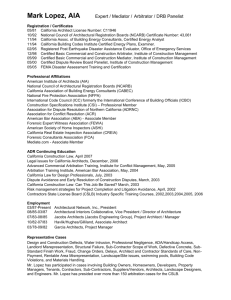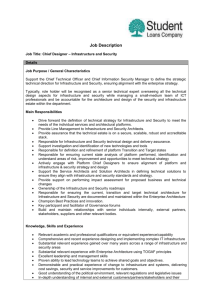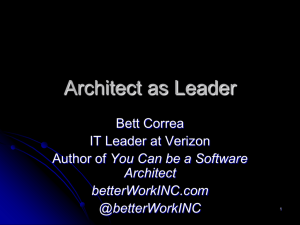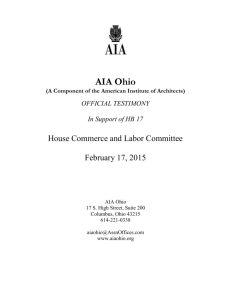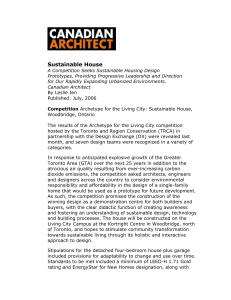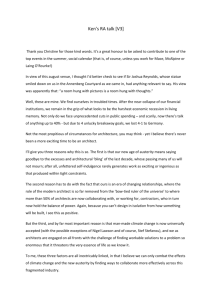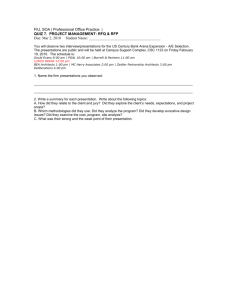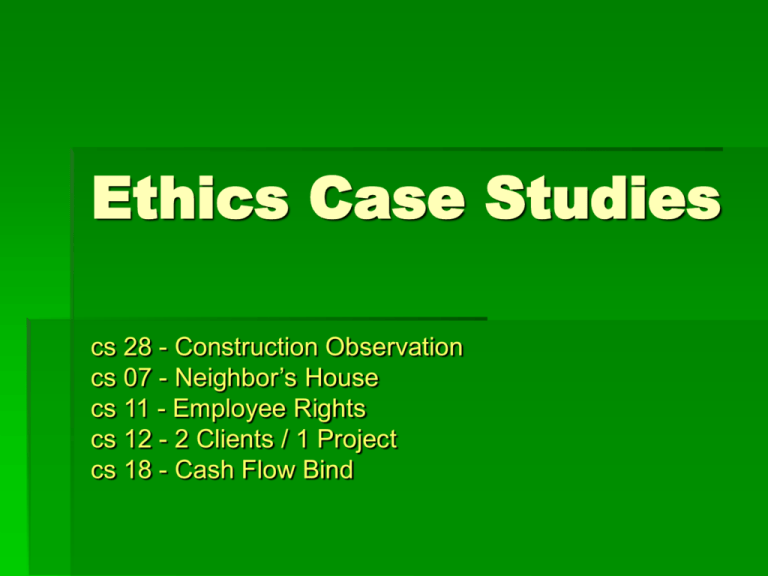
Ethics Case Studies
cs 28 - Construction Observation
cs 07 - Neighbor’s House
cs 11 - Employee Rights
cs 12 - 2 Clients / 1 Project
cs 18 - Cash Flow Bind
cs 07 - Neighbor’s House
Set up
Client = John & Suzie Normal
Architect = Domicile Plus
Site – Lot at cul-de-sac in an exclusive
subdivision
Developer = Mr. Tract
Neighbors = The Bellushis
Lawyer = Mr. Tort
cs 7 – Neighbor’s House
What is the responsibility of the Domicile
+ architects to their original client?
What is the firm’s responsibility of the
Domicile + architects to their new client?
What is the firm’s responsibility of
Domicile + to themselves regarding their
design?
What is the firm’s responsibility of the
new architect, Mr. Clean, to all parties?
cs 28 - Construction Observation
Setup
Client = Contractor/developer
Architect = Young Firm
Site – Condo on sloping site
Sevivce: Drawings only
Limited site info shows a buried
storm/sanitary sewer; no exact location
cs 28 - Construction Observation
Should the architect tell the potential
investor about the construction history?
What are the obligations of the architect
to is original client?
What obligation does the architect have
to report to the city building inspector the
changes?
Should the architect agree to provide the
observation services?
cs 11 - Employee Rights
Setup
Firm A is busy; needs help-temp
Firm B is temporarily slow; work will start
Firm B principal contacts friend who is
principal at Firm A about lending a worker
for 6 months
cs 11 - Employee Rights
Should Firm A offer a permanent position to the
employee?
Should Firm A advise the employee that it would like to
have her join the firm, but indicate it feels a
commitment to honoring its agreement with Firm B?
and therefore return her to Firm A and advertise for
new staff
Does the employe have any responsibility to Firm B?
Does Firm B have any obligation to honor the
employee’s wishes?
If the employee returns to Firm B and then quits shortly
after her return and seeks to be hired by Firm A, what
should be the position of Firm A?
cs12 - 2 Clients / 1 Project
Setup
You are architect for a shopping center
Good client with more work – core and
shell
Tenant improvement is additional service
cs12 - 2 Clients / 1 Project
Do you tell the shell-and-core work client that
you are obligaed to pursue the application for
the tenant client and risk losing this client?
Do your tell the tenant client that you feel that
such a sign would be undesirable from the
point of view of the overall project appearance
and decline to pursue the application?
Do you share your delemma with both clients?
If so, on what basis do you pursue a
resolution?
Do you have any ethical obligations to either
client?
Ethics
► Registration
Statutes & Regulations
► Professional Conduct Rules
► AIA Code of Ethics
► Antitrust Concerns
General
►A
combination of laws, statues and codes regulate
and influence the behavior of practicing architects.
Some are mandated and others are voluntary.
► Mandated controls are included in the state
licensing statutes for the practice of architecture
as well as federal antitrust statutes that set rules
for how businesses compete.
General, cont.
► On
the voluntary side, architects electing to join
professional societies must subscribe to rules of
conduct and ethics established and administered
by those societies.
► Architects play roles in establishing and
administrating some legal and professional ethical
regulations.
They participate in professional degree programs, serve
on registration boards, establish codes of ethics and
adjudicate professional misconduct.
REGISTRATION STATUTES &
REGULATIONS
The authority to enact legislation protecting public
health, safety and welfare – including the authority to
regulate professions – is exercised primarily by the
states.
► The Bill of Rights reserves to the states all powers not
specifically granted by the Constitution to the federal
government. Protecting public health, safety and
welfare is one of these reserved powers. Thus the
regulation of most aspects of design and construction
falls to the states under the Bill of Rights.
►
REGISTRATION STATUTES &
REGULATIONS, cont.
► States
enact legislation governing the registration
of architects and a more detailed set of
administrative rules and regulations, these
typically include:
Define the practice of architecture and limit it to those
who are registered as architects within that jurisdiction
Restrict the use of the title architect to those who are
licensed as architects
Establish requirements for entry to the profession
REGISTRATION STATUTES &
REGULATIONS, cont.
Empower a registration board to establish rules
and regulations
Indicate how architects registered in other
jurisdictions may become registered to practice
in the jurisdiction
Define professional conduct and misconduct
Outline penalties for those who practice
architecture illegally within the jurisdiction
PROFESSIONAL CONDUCT
RULES
► These
rules deal with the governing of
architectural practice and include:
The use of the architect’s seal
Conflict of interest
Disclosure of financial interest in projects and other
aspects of professional behavior
► Each
jurisdiction’s regulations include:
Provisions for filling complaints
Investigating the allegations made in the complaints
Hearing both sides of the issue
Administering penalties
►A
jurisdiction designates an administrative
agency that typically has the power to
admonish, censure, suspend or revoke an
architect’s registration to practice in that
jurisdiction.
► New Jersey State Board of Architects
Common Questions
AIA CODE OF ETHICS
►3
Tier Organization
Canons are broad principles of conduct. The code’s 5
canons are general statements that address professional
responsibilities to the discipline, the public, the client,
the profession and professional colleagues.
Ethical Standards are specific goals toward which
members should aspire in professional practice and
conduct, the 1st ethical standard (E.S. 3.1) under Canon
lll Obligations to the Client, reads:
► “Members should serve their clients in a timely and
competent manner”
AIA CODE OF ETHICS, cont.
Rules of conduct implement the canons and ethical
standards. The canons and ethical standards are stated
in aspirational terms; the rules are mandatory and
describe the floor below which a member’s actions may
not fall. Only a violation of a specific rule of conduct
can be the basis for disciplinary action by the AIA.
Ethical Standard 3.1 states (in part):
► “Members shall not materially alter the scope or
objectives of a project without the client’s consent”
Fiduciary Relationship
► The
retention of a professional designer by a client
– like the relationship between employer and
employee and between partners- creates a
fiduciary relationship
► A fiduciary relationship is contrasted with the
arm’s length relationship. In a commercial
setting parties generally deal at “arm’s length”:
each party must look out for itself. On the other
hand, a fiduciary relationship is a close one, and
the parties must be able to trust each other.
ANTITRUST CONCERNS
► As
with all business enterprises, architects
are prohibited under federal law from
combining with others to engage in
activities that restrain trade or are otherwise
anticompetitive.
ANTITRUST CONCERNS, cont.
► Basic
Principles
Agreements or other joint conduct
between 2 or more competitors that
unreasonably restrain trade are illegal
Fix or maintain prices; (price fixing)
architects must make independent
decisions on fees for their services
ANTITRUST CONCERNS, cont.
Boycott a competitor or customer; an
agreement or understanding among
competing architects not to deal with
another architect or a particular client or
category of client if the purpose is to
limit customer choices
ANTITRUST CONCERNS, cont.
► Allocate
business or customers; a decision
among architects to divide or allocate
customers or markets is unlawful. Even
informal, unwritten understandings that
architects will refrain from doing business
with one another’s clients violate the law.


